
The John Wright Stanly House is a historic home located at New Bern, Craven County, North Carolina. It was probably designed by John Hawks and built about 1779. It is a two-story, five-bay, central hall plan Georgian style frame dwelling. It has a hipped roof and roof deck with balustrade. The building housed a public library from 1935 to 1965. It has been moved twice, coming to its present location in 1965, and subsequently restored as part of the Tryon Palace complex.

The United States Post Office and Courthouse is a courthouse of the United States District Court for the Eastern District of North Carolina, located in New Bern, North Carolina. The building was completed in 1935, and was listed in the National Register of Historic Places in 1973, as a contributing building within the New Bern Historic District, and was individually listed in 2018.

The Benjamin Smith House is a historic home located at New Bern, Craven County, North Carolina. It was built about 1790, and is a 2+1⁄2-story, brick side-hall plan dwelling with Georgian and Federal-style design elements.
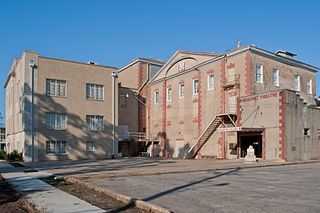
The Masonic Temple, the home of Saint John's Lodge No. 3, A.F. & A.M., is a historic Masonic temple and theatre located at 516 Hancock Street in New Bern, Craven County, North Carolina. It was built between 1802 and 1809, with additions and several alterations. The original section is a very tall, two-story Federal style brick structure, seven bays wide by four bays deep. It sits on a high basement and has a hipped roof. A major addition was made in 1904, and the building was remodeled in 1847 and in 1917. The site was the scene of a duel in 1802.

St. Peter's AME Zion Church is a historic African Methodist Episcopal church located at 615 Queen Street in New Bern, Craven County, North Carolina. It was built between 1923 and 1942, on the site of the 1914 church building which was destroyed by fire in 1922. It is a large three bay by seven bay, rectangular brick church building in the Late Gothic Revival style. It features a gabled nave flanked by two-story truncated stair towers. Also on the property is the contributing 1926 parsonage; a 2+1⁄2-story, frame American Craftsman style dwelling. It is known within the denomination as the "Mother Church of Zion Methodism in the South," and the oldest existing African Methodist Episcopal congregation in the South.

Mount Kisco Municipal Complex is a national historic district located at Mount Kisco, Westchester County, New York. The district contains two contributing buildings; the Mount Kisco Town and Village Hall (1932) and the United States Post Office (1936). Both are in the Colonial Revival style. The Town and Village Hall is a 2-story, cruciform plan brick building on a limestone foundation and topped by a slate-covered hipped and gable roof. It features an octagonal clock tower. The Village Library formerly occupied the second floor until a separate, adjacent building was constructed in the 1960s. The first floor formerly housed the police station and a small jail. The Post Office is a 1+1⁄2-story brick building set on a limestone foundation and topped by a slate shingle clad gable roof. It consists of a central section flanked by 1-story wings, with a large 2-story rear wing. The interior features murals depicting the history of Mount Kisco executed by artist Thomas Donnelly in 1936.

Bryan House and Office is a historic home and office building located at New Bern, Craven County, North Carolina. It was built between 1804 and 1806 on the grounds of the original Tryon Palace. It is a 2+1⁄2-story, three-bay, side-hall plan Federal style brick dwelling. The house was modernized and a rear wing added in 1840. East of the home is a one-story, frame office building on a brick foundation. It was the home of Congressman John Heritage Bryan (1798–1870).
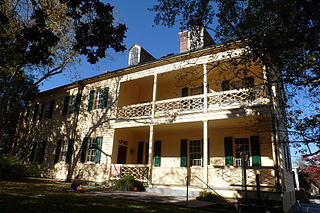
Coor-Gaston House, also known as the Judge William Gaston House, is a historic home located at New Bern, Craven County, North Carolina. It was built in 1774, as determined by dendrochronology, and is a 2+1⁄2-story, "L"-plan, Georgian style frame dwelling with a gable roof. It features a two-tier porch enclosed by Chinese trellis railings and supported by Doric order pillars. It was the home of Congressman and jurist William Gaston (1778-1844).
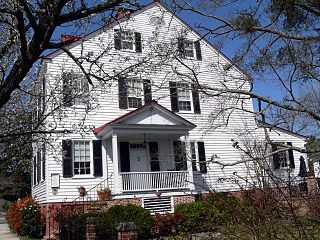
Gull Harbor is a historic home located at New Bern, Craven County, North Carolina, United States. It was built about 1810, and is a 2+1⁄2-story, three-bay, side-hall plan, Federal style frame dwelling.

William Hollister House is a historic home located at New Bern, Craven County, North Carolina. It was built in 1840–1841, and is a 2+1⁄2-story, three-bay, side-hall plan, Federal style frame dwelling. It has a gable roof and a single-story, one-room wing.

Jones–Jarvis House, also known as General Foster's Headquarters and Jarvis–Slover House, is a historic home located at New Bern, Craven County, North Carolina. It was built about 1810, and is a 2+1⁄2-story, three-bay, side-hall plan, Federal-style brick dwelling. It has a one-story brick and frame rear wing. During the American Civil War, General John G. Foster moved into this house, and it served first as his residence and later as part of the headquarters of the Eighteenth Army Corps.

Jerkins-Duffy House, also known as the Clarence B. Beasley House, is a historic home located at New Bern, Craven County, North Carolina. It was built about 1833, and is a 2+1⁄2-story, three-bay, side-hall plan, transitional Federal / Greek Revival style frame dwelling. It has an engaged, full-width two-story rear gallery and one-story wings. It sits on a high brick foundation.

Eli Smallwood House is a historic home located at New Bern, Craven County, North Carolina. It was built about 1810, and is a 2+1⁄2-story, side-hall plan, Federal-style brick town house. It features hand carved ornaments on the main cornice, the porches, and the dormer. The brickwork is laid in Flemish bond. It was the home of Congressmen Charles R. Thomas (1827-1891) and his son Charles R. Thomas (1861–1931) from 1873 to 1925.

Stevenson House is a historic home located at New Bern, Craven County, North Carolina. It was built about 1805, and is a 2+1⁄2-story, three-bay, side hall plan Federal style frame dwelling. It has a two-story east wing added in 1890, and a one-story modern kitchen added in 1957.

Isaac Taylor House, also known as the Taylor-Ward House, is a historic home located at New Bern, Craven County, North Carolina. It was built about 1796, and is a three-story, three-bay, side hall plan Federal-style Flemish bond brick dwelling.
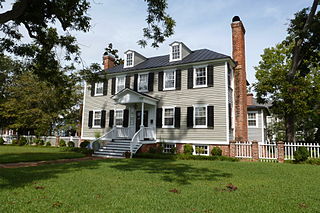
Tisdale–Jones House, also known as the New Bern City Schools Administration Building, is a historic home located at New Bern, Craven County, North Carolina. It was built about 1769, and is a 2+1⁄2-story, central hall plan frame dwelling with a large two-story rear ell. In 1958, the New Bern City Board of Education began using the building as offices; in the 1980s it was returned to private residential use.
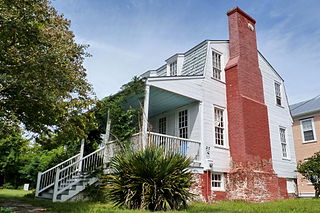
York-Gordon House, more accurately known as the Patrick and Mary Gordon house, is a historic dwelling located at New Bern, Craven County, North Carolina. It was built in 1771, as documented by a letter from Patrick Gordon to William Hooper. Early title research suggested that the house was much older and belonged to Susan York; she evidently lived in an earlier house on this site; her house was probably destroyed in the great storm of 1769. The 1771 house is a 1+1⁄2-story, five-bay, frame dwelling with a gambrel roof and Georgian style design elements. A Federal chimneypiece replaced an earlier Georgian chimneypiece in the early 19 century. The house is sheathed in shiplap siding over brick-filled walls, rests on a brick over ballast stone foundation and features a full-width, one-story shed-roof porch, which was added 1786, based on estate records.

Rhem-Waldrop House, also known as the John L. Rhem House, is a historic home located at New Bern, Craven County, North Carolina. It was built about 1855, and is a 2+1⁄2-story, five bay by four bay, stuccoed brick dwelling in the Renaissance Revival style. It has a high deck-on-hip roof with dormers and a semicircular entrance porch with fluted columns.
Gray-Brownlow-Wilcox House, also known as La Vallee, is a historic plantation house located at Aurelian Springs, Halifax County, North Carolina. It was built about 1820, and is a 2+1⁄2-story, three-bay, Federal-style frame dwelling. It has a temple-form and pedimented gable front facade. Located behind the house is a 1+1⁄2-story frame building that housed Brownlow's Female Academy from about 1833 to 1851.
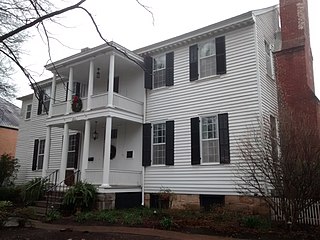
Haywood Hall, also known as the Treasurer John Haywood House, is a historic home located at Raleigh, Wake County, North Carolina, United States. It was built in 1792, and is a two-story, five-bay, Federal-style frame dwelling with a central hall plan. It features a two-story front porch with attenuated fluted Doric order columns. It was the home of North Carolina State Treasurer John Haywood (1754–1827). It is now open as a historic house museum.























